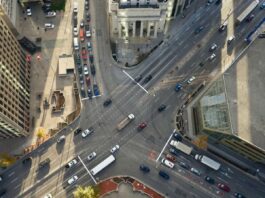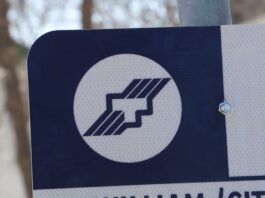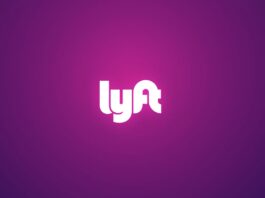The final chapter is here. Basically everything’s been said at this point. Yes, Winnipeg seems to have been embroiled in transit debates for decades. No, there is no likelihood of a solution like this or anything aside from continued “planning” in rapid/mass transit ever happening. Does that mean that this can’t be an interesting read? You decide. With that I give the floor to Marty.
____________
This is the third in a three-part series. In the first instalment I talked about what I hate about the bus system. The second article explained why the bus system is messed up. Today I will show how easy it would be to fix the system. My plan involves a little more walking and a lot less waiting.
Winnipeg Transit presently runs an average of 4000 bus-hours per day. This is the equivalent of 200 busses running from 6:00am to 2:00am seven days a week. Many of those busses meander up and down dinky little regional routes virtually empty of passengers. I’m going to show how to allocate those busses where it will make a difference.
The key to my plan is NO DUPLICATION. If you’re standing on Main Street waiting for a bus, the next bus that comes will be YOUR bus because it will be the ONLY bus running on that street.
Winnipeg Transit presently runs between sixty and seventy different routes. My plan has less than half the number of routes: twenty-seven to be exact, consisting of six different classes: Inner Loop, Radial Spur (9 routes), Outer Loop, Filler Route (12 routes), Downtown Shuttle (3 routes), and the University Shuttle. I cover 90% of the city at a frequency of every five minutes, and 99% at ten minutes or better with a maximum fifteen minute (1.2 km) walk. Here’s how it works:
1. The Inner Loop.This is the centerpiece of my plan. The loop circumnavigates the downtown via Main Street – Broadway- Sherbrooke – William. It takes twenty minutes and runs in the clockwise direction only, so there are no left turns. There are twenty busses on the loop spaced one minute apart, so there is virtually no waiting.
2. The Outer Loop. This basically follows the beltway: Bishop Grandin – Kenaston – King Edward – Leila/Springfield Road. Here and there it cuts through residential territory
like the Maples via Mandalay/Adsum, McLeod/Grassie, and Autumwood/Lakewood.
Twenty busses in each direction run six minutes apart, stopping every 3/4 mile.
3. Radial Spurs. There are nine key radial spurs which, together with the Inner and Outer Loops, cover 90% of the city: Portage, Notre Dame, McPhillips, Main Street, Henderson, Nairn, Marion, Ste. Annes, Pembina and Grant. These routes terminate AT THE INNER LOOP, so they don’t waste 25% of their time meandering through downtown. That means they spend more time delivering people to where they need to go.I get another 25% increase in efficiency by running them as express busses, stopping only every 3/4 mile. The best part: you won’t mind missing the bus if it passes you on the street because the next one will be only FIVE MINUTES away. I need one hundred busses to cover the radial spurs.
4. Filler Routes. My radial spurs leave about 10% of the residential population more than one kilometer from a bus line. For example, 80% of the traditional North End is covered by my Main Street, McPhillips, and Outer Loop routes. City Transit presently fills in the remainder with no less than five additional routes: Arlington, McGregor, Salter, Mountain, and Selkirk. Some of these busses only come every half hour. In my system, I complete the North End with exactly one additional filler, the Arlington/McGregor Loop which crosses the Salter Bridge and terminates at the Health Sciences. I run a total of forty-two busses on twelve different Filler Routes at a frequency of one bus every ten minutes.
5. Downtown Shuttles. No, not the free milk runs presently operated by the city. At present, the typical bus route spends 25% of its time plowing through downtown. All of my radial spurs terminate at the Inner Loop, leaving the downtown wide open. I cover the entire downtown with twelve busses running three shuttle routes: Portage from Main to Sherbrook, Osborne/Isabel from William to Broadway, and Donald/Princess/Notre Dame from (get this): Confusion Corner to the Health Science Center. Twelve busses give you complete coverage EVERY TWO MINUTES to within one block of any point within the inner loop. To put this in perspective, understand that at present, there are probably over FORTY BUSSES within the downtown region at any given moment. And take a look sometime: three-quarters of them are virtually empty.
6. The University Shuttle picks up passengers from three different routes (Pembina, Outer Loop, and Markham/Dalhousie) and shuttles them into the campus. I need four busses to provide pick-ups every two minutes.
And that’s the plan. I count two hundred and sixteen busses, as compared to two hundred at present. But that’s based on maximum coverage twenty hours per day. In actual practise, you would naturally cut back some routes after six PM. Taking into account a reasonable utilization factor during off-hours, I’m probably able to reduce the city’s total bus-hours by ten or twenty percent. On an annual budget of a hundred million dollars, that’s a bit of a saving. But the real point isn’t to save money, it’s to get people where they need to go. And that’s what my system actually does.
Image Winnipeg Transit Originally uploaded by anastaz1a




